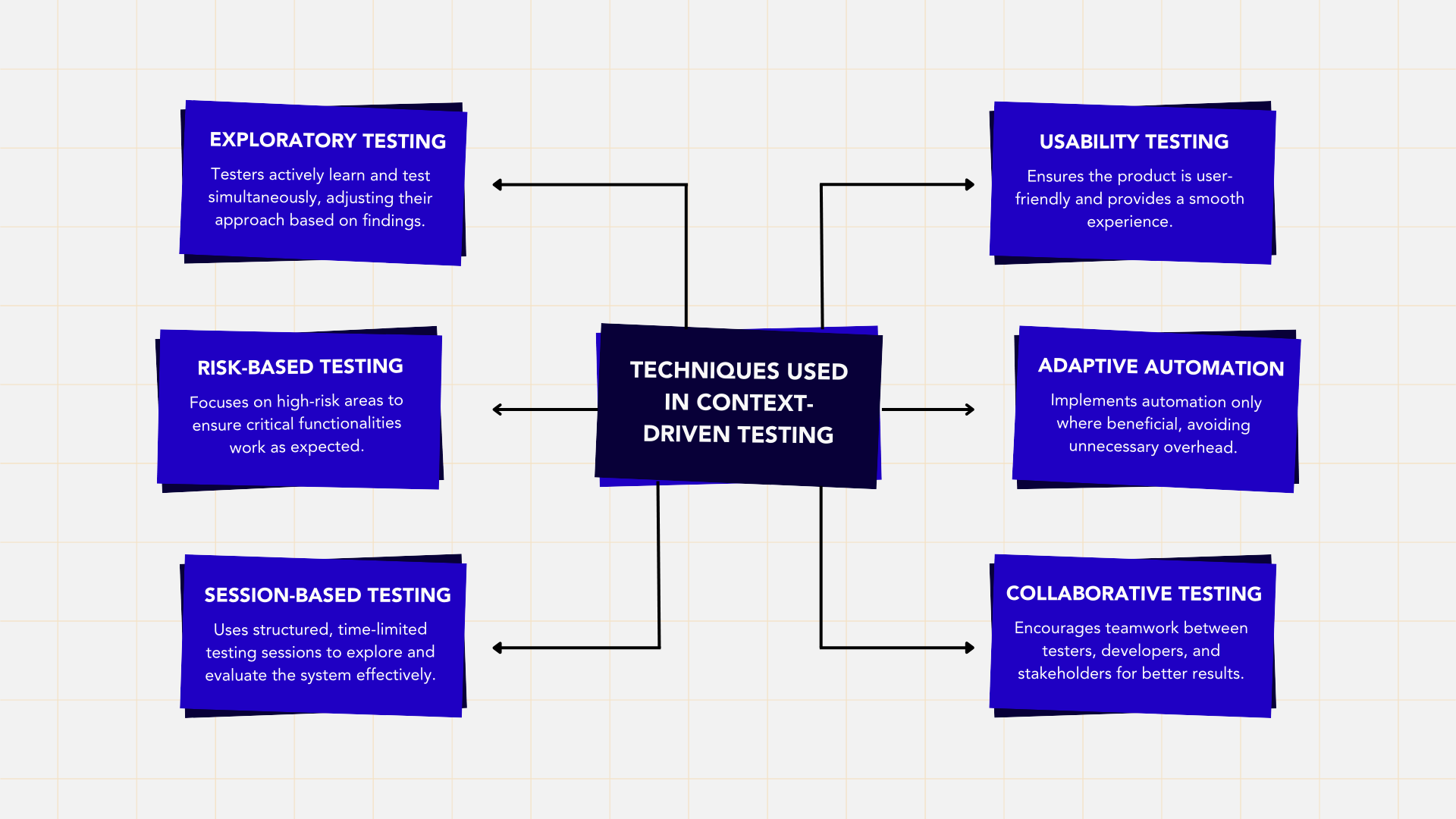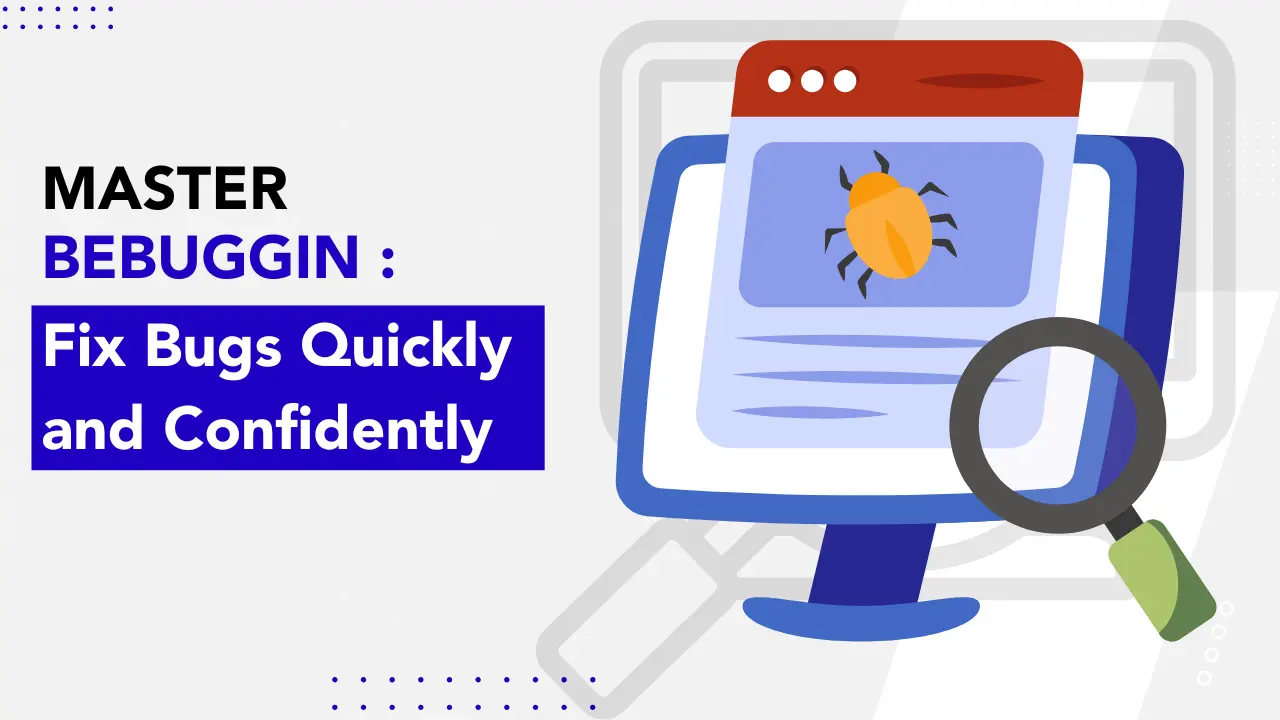
by Arthur Williams | Mar 22, 2025 | Software Testing, Blog, Latest Post |
As applications shift from large, single-system designs to smaller, flexible microservices, it is very important to ensure that each of these parts works well and performs correctly. This guide will look at the details of microservices testing. We will explore various methods, strategies, and best practices that help create a strong development process. A clear testing strategy is very important for applications built on microservices. Since these systems are independent and spread out, you need a testing approach that solves their unique problems. The strategy should include various types of testing, each focusing on different parts of how the system works and performs.
Testing must be a key part of the development process. It should be included in the CI/CD pipeline to check that changes are validated well before they go live. Automated testing is essential to handle the complexity and provide fast feedback. This helps teams find and fix issues quickly.
Key Challenges in Microservices Testing
Before diving into testing strategies, it’s important to understand the unique challenges of microservices testing:
- Service Independence: Each microservice runs as an independent unit, requiring isolated testing.
- Inter-Service Communication: Microservices communicate via REST, gRPC, or messaging queues, making API contract validation crucial.
- Data Consistency Issues: Multiple services access distributed databases, increasing the risk of data inconsistency.
- Deployment Variability: Different microservices may have different versions running, requiring backward compatibility checks.
- Fault Tolerance & Resilience: Failures in one service should not cascade to others, necessitating chaos and resilience testing.
To tackle these challenges, a layered testing strategy is necessary.
Microservices Testing Strategy:
Testing microservices presents unique challenges due to their distributed nature. To ensure seamless communication, data integrity, and system reliability, a well-structured testing strategy must be adopted.
1. Services Should Be Tested Both in Isolation and in Combination
Each microservice must be tested independently before being integrated with others. A well-balanced approach should include:
- Component testing, which verifies the correctness of individual services in isolation.
- Integration testing, which ensures seamless communication between microservices
By implementing both strategies, issues can be detected early, preventing major failures in production.
2. Contract Testing Should Be Used to Prevent Integration Failures
Since microservices communicate through APIs, even minor changes may disrupt service dependencies. Contract testing plays a crucial role in ensuring proper interaction between services and reducing the risk of failures during updates.
- API contracts should be clearly defined and maintained to ensure compatibility.
- Tools such as Pact and Spring Cloud Contract should be used for contract validation.
- Contract testing should be integrated into CI/CD pipelines to prevent deployment issues.
3. Testing Should Begin Early (Shift-Left Approach)
Traditionally, testing has been performed at the final stages of development, leading to late-stage defects that are costly to fix. Instead, a shift-left testing approach should be followed, where testing is performed from the beginning of development.
- Unit and integration tests should be written as code is developed.
- Testers should be involved in requirement gathering and design discussions to identify potential issues early.
- Code reviews and pair programming should be encouraged to enhance quality and minimize defects.
4. Real-World Scenarios Should Be Simulated with E2E and Performance Testing
Since microservices work together as a complete system, they must be tested under real-world conditions. End-to-End (E2E) testing ensures that entire business processes function correctly, while performance testing checks if the system remains stable under different workloads.
- High traffic simulations should be conducted using appropriate tools to identify bottlenecks.
- Failures, latency, and scaling issues should be assessed before deployment.
This helps ensure that the application performs well under real user conditions and can handle unexpected loads without breaking down.
Example real-world conditions :
- E-Commerce Order Processing: Ensures seamless communication between shopping cart, inventory, payment, and order fulfillment services.
- Online Payments with Third-Party Services: Verifies secure and successful transactions between internal payment services and providers like PayPal or Stripe.
- Public API for Inventory Checking: Confirms real-time stock availability for external retailers while maintaining data security and system performance.
5. Security Testing Should Be Integrated from the Start
Security remains a significant concern in microservices architecture due to the multiple services that expose APIs. To minimize vulnerabilities, security testing must be incorporated throughout the development lifecycle.
- API security tests should be conducted to verify authentication and data protection mechanisms.
- Vulnerabilities such as SQL injection, XSS, and CSRF attacks should be identified and mitigated.
- Security tools like OWASP ZAP, Burp Suite, and Snyk should be used for automated testing.
6. Observability and Monitoring Should Be Implemented for Faster Debugging
Since microservices generate vast amounts of logs and metrics, observability and monitoring are essential for identifying failures and maintaining system health.
- Centralized logging should be implemented using ELK Stack or Loki.
- Distributed tracing with Jaeger or OpenTelemetry should be used to track service interactions.
- Real-time performance monitoring should be conducted using Prometheus and Grafana to detect potential issues before they affect users.
Identifying Types of Tests for Microservices
1. Unit Testing – Testing Small Parts of Code
Unit testing focuses on testing individual functions or methods within a microservice to ensure they work correctly. It isolates each piece of code and verifies its behavior without involving external dependencies like databases or APIs.
- They write test cases for small functions.
- They mock (replace) databases or external services to keep tests simple.
- Run tests automatically after every change.
Example:
A function calculates a discount on products. The tester writes tests to check if:
- A 10% discount is applied correctly.
- The function doesn’t crash with invalid inputs.
Tools: JUnit, PyTest, Jest, Mockito
2. Component Testing – Testing One Microservice Alone
Component testing validates a single microservice in isolation, ensuring its APIs, business logic, and database interactions function correctly. It does not involve communication with other microservices but may use mock services or in-memory databases for testing.
- Use tools like Postman to send test requests to the microservice.
- Check if it returns correct data (e.g., user details when asked).
- Use fake databases to test without real data.
Example:
Testing a Login Service:
- The tester sends a request with a username and password.
- The system must return a success message if login is correct.
- It must block access if the password is wrong.
Tools: Postman, REST-assured, WireMock
3. Contract Testing – Making Sure Services Speak the Same Language
Contract testing ensures that microservices communicate correctly by validating API agreements between a provider (data sender) and a consumer (data receiver). It prevents breaking changes when microservices evolve independently.
- The service that sends data (Provider) and the service that receives data (Consumer) create a contract (rules for communication).
- Testers check if both follow the contract.
Example:
Order Service sends details to Payment Service.
If the contract says:
{
"order_id": "12345",
"amount": 100.0
}
The Payment Service must accept this format.
- If Payment Service changes its format, contract testing will catch the error before release.
Tools: Pact, Spring Cloud Contract
4. Integration Testing – Checking If Microservices Work Together
Integration testing verifies how multiple microservices interact, ensuring smooth data flow and communication between services. It detects issues like incorrect API responses, broken dependencies, or failed database transactions.
- They set up a test environment where services can talk to each other.
- Send API requests and check if the response is correct.
- Use mock services if a real service isn’t available.
Example:
Order Service calls Inventory Service to check stock:
- Tester sends a request to place an order.
- The system must reduce stock in the Inventory Service.
Tools: Testcontainers, Postman, WireMock
5. End-to-End (E2E) Testing – Testing the Whole System Together
End-to-End testing validates the entire business process by simulating real user interactions across multiple microservices. It ensures that all services work cohesively and that complete workflows function as expected.
- Test scenarios are created from a user’s perspective.
- Clicks and inputs are automated using UI testing tools.
- Data flow across all services is checked.
Example:
E-commerce checkout process:
- User adds items to cart.
- User completes payment.
- Order is confirmed, and inventory is updated.
- Tester ensures all steps work without errors.
Tools: Selenium, Cypress, Playwright
6. Performance & Load Testing – Checking Speed & Stability
Performance and load testing evaluate how well microservices handle different levels of user traffic. It helps identify bottlenecks, slow responses, and system crashes under stress conditions to ensure scalability and reliability.
- Thousands of fake users are created to send requests.
- System performance is monitored to find weak points.
- Slow API responses are identified, and fixes are suggested.
Example:
- An online shopping website expects 1,000 users at the same time.
- Testers simulate high traffic and see if the website slows down.
Tools: JMeter, Gatling, Locust
7. Chaos Engineering – Testing System Resilience
Chaos engineering deliberately introduces failures like server crashes or network disruptions to test how well microservices recover. It ensures that the system remains stable and continues functioning even in unpredictable conditions.
- Use tools to randomly shut down microservices.
- Monitor if the system can recover without breaking.
- Check if users get error messages instead of crashes.
Example:
- Tester disconnects the database from the Order Service.
- The system should retry the connection instead of crashing.
Tools: Chaos Monkey, Gremlin
8. Security Testing – Protecting Against Hackers
Security testing identifies vulnerabilities in microservices, ensuring they are protected against cyber threats like unauthorized access, data breaches, and API attacks. It checks authentication, encryption, and compliance with security best practices.
- Test login security (password encryption, token authentication).
- Check for common attacks (SQL Injection, Cross-Site Scripting).
- Run automated scans for security vulnerabilities.
Example:
- A tester tries to enter malicious code into a login form.
- If the system is secure, it should block the attempt.
Tools: OWASP ZAP, Burp Suite
9. Monitoring & Observability – Watching System Health
Monitoring and observability track real-time system performance, errors, and logs to detect potential issues before they impact users. It provides insights into system health, helping teams quickly identify and resolve failures.
- Use logging tools to track errors.
- Use tracing tools to see how requests travel through microservices.
- Set up alerts for slow or failing services.
Example:
If the Order Service stops working, an alert is sent to the team before users notice.
Tools: Prometheus, Grafana, ELK Stack
Conclusion
A structured microservices testing strategy ensures early issue detection, improved reliability, and faster software delivery. By adopting test automation, early testing (shift-left), contract validation, security assessments, and continuous monitoring, organizations can enhance the stability and performance of microservices-based applications. To maintain a seamless software development cycle, testing must be an ongoing process rather than a final step. A proactive approach ensures that microservices function as expected, providing a better user experience and higher system reliability.
Frequently Asked Questions
-
Why is testing critical in microservices architecture?
Testing ensures each microservice works independently and together, preventing failures, maintaining system reliability, and ensuring smooth communication between services.
-
What tools are commonly used for microservices testing?
Popular tools include JUnit, Pact, Postman, Selenium, Playwright, JMeter, OWASP ZAP, Prometheus, Grafana, and Chaos Monkey.
-
How is microservices testing different from monolithic testing?
Microservices testing focuses on validating independent, distributed components and their interactions, whereas monolithic testing typically targets a single, unified application.
-
Can microservices testing be automated?
Yes, automation is critical in microservices testing for unit tests, integration tests, API validations, and performance monitoring within CI/CD pipelines.

by Charlotte Johnson | Mar 6, 2025 | Software Testing, Blog, Latest Post |
Many traditional software testing methods follow strict rules, assuming that the same approach works for every project. However, every software project is different, with unique challenges, requirements, and constraints. Context-Driven Testing (CDT) is a flexible testing approach that adapts strategies based on the specific needs of a project instead of following fixed best practices, CDT encourages testers to think critically and adjust their methods based on project goals, team skills, budget, timelines, and technical limitations. This approach was introduced by Cem Kaner, James Bach, and Bret Pettichord, who emphasized that there are no universal testing rules—only practices that work well in a given context. CDT is particularly useful in agile projects, startups, and rapidly changing environments where requirements often shift. It allows testers to adapt in real time, ensuring testing remains relevant and effective. Unlike traditional methods that focus only on whether the software meets requirements, CDT ensures the product actually solves real problems for users. By promoting flexibility, collaboration, and problem-solving, Context-Driven Testing helps teams create high-quality software that meets both business and user expectations. It is a practical, efficient, and intelligent approach to testing in today’s fast-paced software development world.
The Evolution of Context-Driven Testing in Software Development
Software testing has evolved from rigid, standardized processes to more flexible and adaptive approaches. Context-driven testing (CDT) emerged as a response to traditional frameworks that struggled to handle the unique needs of different projects.
Early Testing: A Fixed Approach
Initially, software testing followed strictly defined processes with heavy documentation and structured test cases. Waterfall models required extensive upfront planning, making it difficult to adapt to changes. These methods often led to:
- Lack of flexibility in dynamic projects
- Inefficient use of resources, focusing on documentation over actual testing
- Misalignment with business needs, causing ineffective testing outcomes
The Shift Toward Agile and Exploratory Testing
With the rise of Agile development, testing became more iterative and collaborative, allowing testers to:
- Think critically instead of following rigid scripts
- Adapt quickly to changes in project requirements
- Prioritize business value over just functional correctness
However, exploratory testing lacked a structured decision-making framework, leading to the need for Context-Driven Testing.
The Birth of Context-Driven Testing
CDT was introduced by Cem Kaner, James Bach, and Bret Pettichord as a flexible, situational approach to testing. It focuses on:
- Tailoring testing methods based on project context
- Encouraging collaboration between testers, developers, and stakeholders
- Adapting continuously as projects evolve
This made CDT highly effective for Agile, DevOps, and fast-paced development environments.
CDT in Modern Software Development
Today, CDT remains crucial in handling complex software systems such as AI-driven applications and IoT devices. It continues to evolve by:
- Integrating AI-based testing for smarter test coverage
- Working with DevOps for continuous, real-time testing
- Focusing on risk-based testing to address critical system areas
By adapting to real-world challenges, CDT ensures efficient, relevant, and high-impact testing in today’s fast-changing technology landscape.
The Seven Key Principles of Context-Driven Testing
1. The value of any practice depends on its context.
2. There are good practices in context, but there are no best practices.
3. People, working together, are the most important part of any project’s context.
4. Projects unfold over time in ways that are often not predictable.
5. The product is a solution. If the problem isn’t solved, the product doesn’t work.
6. Good software testing is a challenging intellectual process.
7. Only through judgment and skill, exercised cooperatively throughout the entire project, are we able to do the right things at the right times to effectively test our products.

Step-by-Step Guide to Adopting Context-Driven Testing
Adopting Context-Driven Testing (CDT) requires a flexible mindset and a willingness to adapt testing strategies based on project needs. Unlike rigid frameworks, CDT focuses on real-world scenarios, team collaboration, and continuous learning. Here’s how to implement it effectively:
- Understand the Project Context – Identify key business goals, technical constraints, and potential risks to tailor the testing approach.
- Choose the Right Testing Techniques – Use exploratory testing, risk-based testing, or session-based testing depending on project requirements.
- Encourage Tester Autonomy – Allow testers to make informed decisions and think critically rather than strictly following predefined scripts.
- Collaborate with Teams – Work closely with developers, business analysts, and stakeholders to align testing efforts with real user needs.
- Continuously Adapt – Modify testing strategies as the project evolves, focusing on areas with the highest impact.
By following these steps, teams can ensure effective, relevant, and high-quality testing that aligns with real-world project demands.
Case Studies: Context-Driven Testing in Action
These case studies demonstrate how Context-Driven Testing (CDT) adapts to different industries and project needs by applying flexible, risk-based, and user-focused testing methods. Unlike rigid testing frameworks, CDT helps teams prioritize critical aspects, optimize testing efforts, and adapt to evolving requirements, ensuring high-quality software that meets real-world demands.
Case Study 1: Ensuring Security in Online Banking
Client: A financial institution launching an online banking platform.
Challenge: Ensuring strict security and compliance due to financial regulations.
How CDT Helps:
Banking applications deal with sensitive financial data, making security and compliance top priorities. CDT allows testers to focus on high-risk areas, choosing testing techniques that best suit security needs instead of following a generic testing plan.
Context-Driven Approach:
- Security Testing: Identified vulnerabilities like SQL injection, unauthorized access, and session hijacking through exploratory security testing.
- Compliance Testing: Ensured the platform met industry regulations (e.g., PCI-DSS, GDPR) by adapting testing to legal requirements.
- Load Testing: Simulated peak transaction loads to check performance under heavy usage.
- Exploratory Testing: Assessed UI/UX usability, identifying any issues affecting the user experience.
Outcome: A secure, compliant, and user-friendly banking platform that meets regulatory requirements while providing a smooth customer experience.
Case Study 2: Handling High Traffic for an E-Commerce Platform
Client: A startup preparing for a Black Friday sale.
Challenge: Ensuring the website can handle high traffic volumes without performance failures.
How CDT Helps:
E-commerce businesses face seasonal traffic spikes, which can lead to website crashes and lost sales. CDT helps by prioritizing performance and scalability testing while considering time and budget constraints.
Context-Driven Approach:
- Performance Testing: Simulated real-time Black Friday traffic to test site stability under heavy loads.
- Cloud-Based Load Testing: Used cost-effective cloud testing tools to manage high-traffic scenarios within budget.
- Collaboration with Developers: Worked closely with developers to identify and resolve bottlenecks affecting website performance.
Outcome: A stable, high-performing e-commerce website capable of handling increased user traffic without downtime, maximizing sales during peak shopping events.
Case Study 3: Testing an IoT-Based Smart Home Device
Client: A company launching a smart thermostat with WiFi and Bluetooth connectivity.
Challenge: Ensuring seamless connectivity, ease of use, and durability in real-world conditions.
How CDT Helps:
Unlike standard software applications, IoT devices operate in varied environments with different network conditions. CDT allows testers to focus on real-world usage scenarios, adapting testing based on device behavior and user expectations.
Context-Driven Approach:
- Usability Testing: Ensured non-technical users could set up and configure the device easily.
- Network Testing: Evaluated WiFi and Bluetooth stability under different network conditions.
- Environmental Testing: Tested durability by simulating temperature and humidity variations.
- Real-World Scenario Testing: Assessed performance outside lab conditions, ensuring the device functions as expected in actual homes.
Outcome: A user-friendly, reliable smart home device tested under real-world conditions, ensuring smooth operation for end users.
Advantages of Context-Driven Testing
- Adaptability: Adjusts to project-specific needs rather than following rigid processes.
- Focus on Business Goals: Ensures testing efforts align with what matters most to the business.
- Encourages Critical Thinking: Testers make informed decisions rather than blindly executing test cases.
- Effective Resource Utilization: Saves time and effort by prioritizing relevant tests.
- Higher Quality Feedback: Testing aligns with real-world usage rather than theoretical best practices.
- Increased Collaboration: Encourages better communication between testers, developers, and stakeholders.
Challenges of Context-Driven Testing
- Requires Skilled Testers: Testers must have deep analytical skills and domain knowledge.
- Difficult to Standardize: Organizations that prefer fixed processes may find it hard to implement.
- Needs Strong Communication: Collaboration is key, as the approach depends on aligning with stakeholders.
- Potential Pushback from Management: Some organizations prefer strict guidelines and may resist a flexible approach.
Best Practices for Context-Driven Testing Success
To effectively implement Context-Driven Testing (CDT), teams must embrace flexibility, critical thinking, and collaboration. Here are some best practices to ensure success:
- Understand the Project Context – Identify business goals, user needs, technical limitations, and risks before choosing a testing approach.
- Choose Testing Techniques Wisely – Use exploratory, risk-based, or session-based testing based on project requirements.
- Encourage Tester Independence – Allow testers to think critically, explore, and adapt instead of just following predefined scripts.
- Promote Collaboration – Engage developers, business analysts, and stakeholders to align testing with business needs.
- Be Open to Change – Adjust testing strategies as requirements evolve and new challenges arise.
- Balance Manual and Automated Testing – Automate only where valuable, focusing on repetitive or high-risk areas.
- Measure and Improve Continuously – Track testing effectiveness, gather feedback, and refine the process for better results.
Conclusion
Context-Driven Testing (CDT) is a flexible, adaptive, and real-world-focused approach that ensures testing aligns with the unique needs of each project. Unlike rigid, predefined testing methods, CDT allows testers to think critically, collaborate effectively, and adjust strategies based on evolving project requirements. This makes it especially valuable in Agile, DevOps, and rapidly changing development environments. For businesses looking to apply CDT effectively, Codoid offers expert testing services, including exploratory, automation, performance, and usability testing. Their customized approach helps teams build high-quality, user-friendly software while adapting to project challenges.
Frequently Asked Questions
-
What Makes Context-Driven Testing Different from Traditional Testing Approaches?
Context-driven testing is about adjusting to the specific needs of a project instead of sticking to set methods. It is different from the traditional way of testing. This approach values flexibility and creativity, helping to meet specific needs well. By using this tailored method, it improves test coverage and makes sure testing work closely matches the project goals.
-
How Do You Determine the Context for a Testing Project?
To understand the project context for testing, you need to look at project requirements, the needs of stakeholders, and current systems. Think about things like how big the project is, its timeline, and any risks involved. These factors will help you adjust your testing plan. Using development tools can also help make sure your testing fits well with the project context.
-
Can Context-Driven Testing Be Automated?
Context-driven testing cannot be fully automated. This is because it relies on being flexible and understanding human insights. Still, automated tools can help with certain tasks, like regression testing. They allow for manual work when understanding the details of a situation is important.
-
How Does Context-Driven Testing Fit into DevOps Practices?
Context-driven testing works well with DevOps practices by adjusting to the changing development environment. It focuses on being flexible, getting quick feedback, and working together, which are important in continuous delivery. By customizing testing for each project, it improves software quality and speeds up deployment cycles.
-
What Are the First Steps in Transitioning to Context-Driven Testing?
To switch to context-driven testing, you need to know the project requirements very well. Adjust your test strategies to meet these needs. Work closely with stakeholders to ensure everyone is on the same page with testing. Include ways to gather feedback for ongoing improvement and flexibility. Use tools that fit in well with adaptable testing methods.

by Chris Adams | Feb 4, 2025 | Software Testing, Blog, Latest Post |
Without proper test data, software testing can become unreliable, leading to poor test coverage, false positives, and overlooked defects. Managing test data effectively not only enhances the accuracy of test cases but also improves compliance, security, and overall software reliability. Test Data Management involves the creation, storage, maintenance, and provisioning of data required for software testing. It ensures that testers have access to realistic, compliant, and relevant data while avoiding issues such as data redundancy, security risks, and performance bottlenecks. However, maintaining quality test data can be challenging due to factors like data privacy regulations (GDPR, CCPA), environment constraints, and the complexity of modern applications.
To overcome these challenges, adopting best practices in TDM is essential. In this blog, we will explore the best practices, tools, and techniques for effective Test Data Management to help testers achieve scalability, security, and efficiency in their testing processes.
The Definition and Importance of Test Data Management
Test Data Management (TDM) is very important in software development. It is all about creating and handling test data for software testing. TDM uses tools and methods to help testing teams get the right data in the right amounts and at the right time. This support allows them to run all the test scenarios they need.
By implementing effective Test Data Management (TDM) practices, they can test more accurately and better. This leads to higher quality software, lower development costs, and a faster time to market.
Strategies for Efficient Test Data Management
Building a good test data management plan is important for organizations. To succeed, we need to set clear goals. We should also understand our data needs. Finally, we must create simple ways to create, store, and manage data.
It is important to work with the development, testing, and operations teams to get the data we need. It is also important to automate the process to save time. Following best practices for data security and compliance is essential. Both automation and security are key parts of a good test data management strategy.
1. Data Masking and Anonymization
Why?
- Protects sensitive data such as Personally Identifiable Information (PII), financial records, and health data.
- Ensures compliance with data protection regulations like GDPR, HIPAA, and PCI-DSS.
Techniques
- Static Masking: Permanently replaces sensitive data before use.
- Dynamic Masking: Temporarily replaces data when accessed by testers.
- Tokenization: Replaces sensitive data with randomly generated tokens.
Example
If a production database contains customer details:
| S.No |
Customer Name |
Credit Card Number |
Email |
| 1 |
John Doe |
4111-5678-9123-4567 |
[email protected] |
| S.No |
Customer Name |
Credit Card Number |
Email |
| 1 |
Customer_001 |
4111-XXXX-XXXX-4567 |
[email protected] |
SQL-based Masking:
UPDATE customers
SET email = CONCAT('user', id, '@masked.com'),
credit_card_number = CONCAT(SUBSTRING(credit_card_number, 1, 4), '-XXXX-XXXX-', SUBSTRING(credit_card_number, 16, 4));
2. Synthetic Data Generation
Why?
- Creates realistic but artificial test data.
- Helps test edge cases (e.g., users with special characters in their names).
- Avoids legal and compliance risks.
Example
Generate fake customer data using Python’s Faker library:
from faker import Faker
fake = Faker()
for _ in range(5):
print(fake.name(), fake.email(), fake.address())
3. Data Subsetting
Why?
- Reduces large production datasets into smaller, relevant test datasets.
- Improves performance by focusing on specific test scenarios.
Example
Extract only USA-based customers for testing:
SELECT * FROM customers WHERE country = 'USA' LIMIT 1000;
OR use a tool like Informatica TDM or Talend to extract subsets.
4. Data Refresh and Versioning
Why?
- Maintains consistency across test runs.
- Allows rollback in case of faulty test data.
Techniques
- Use version-controlled test data snapshots (e.g., Git or database backups).
- Automate data refreshes before major test cycles.
Example
Backup Test Data:
mysqldump -u root -p test_db > test_data_backup.sql
mysql -u root -p test_db < test_data_backup.sql
5. Test Data Automation
Why?
- Eliminates manual effort in loading and managing test data.
- Integrates with CI/CD pipelines for continuous testing.
Example
Use CI/CD pipeline (GitLab CI, Jenkins) to load test data:
stages:
- setup
- test
jobs:
setup:
script:
- mysql < test_data.sql
test:
script:
- pytest test_suite.py
6. Data Consistency and Reusability
Why?
- Prevents test flakiness due to inconsistent data.
- Reduces the cost of recreating test data.
Techniques
- Store centralized test datasets for all environments.
- Use parameterized test data for multiple test cases.
Example
A shared test data API to fetch reusable data:
import requests
def get_test_data(user_id):
response = requests.get(f"https://testdata.api.com/users/{user_id}")
return response.json()
7. Parallel Data Provisioning
Why?
- Enables simultaneous testing in multiple environments.
- Improves test execution speed for parallel testing.
Example
Use Docker containers to provision test databases:
docker run -d --name test-db -e MYSQL_ROOT_PASSWORD=root -p 3306:3306 mysql
Each test run gets an isolated database environment.
8. Environment-Specific Data Management
Why?
- Prevents data leaks by maintaining separate datasets for:
- Development (dummy data)
- Testing (masked production data)
- Production (real data)
Example
Configure environment-based data settings in a .env file:
# Dev environment
DB_NAME=test_db
DB_HOST=localhost
DB_USER=test_user
DB_PASS=test_pass
9. Data Compliance and Regulatory Considerations
Why?
- Ensures compliance with GDPR, HIPAA, CCPA, PCI-DSS.
- Prevents lawsuits and fines due to data privacy violations.
Example
Use GDPR-compliant anonymization:
UPDATE customers
SET email = CONCAT('user', id, '@example.com'),
phone = 'XXXXXX';
Overcoming Common Test Data Management Challenges
Test data management is crucial, but it comes with challenges for organizations, especially when handling sensitive test data sets, which can include production data. Organizations must follow privacy laws. They also need to make sure the data is reliable for testing purposes.
It can be tough to keep data quality, consistency, and relevance during testing. Finding the right mix of realistic data and security is difficult. It’s also important to manage how data is stored and to track different versions. Moreover, organizations must keep up with changing data requirements, which can create more challenges.
1. Large Test Data Slows Testing
Problem: Large datasets can slow down test execution and make it less effective.
Solution:
- Use only a small part of the data that is needed for testing.
- Run tests at the same time with separate data for quicker results.
- Think about using fast memory stores or simple storage options for speed.
2. Test Data Gets Outdated
Problem: Test data can become old or not match with production. This can make tests not reliable.
Solution:
- Automate test data updates to keep it in line with production.
- Use control tools for data to make sure it is the same.
- Make sure test data gets updated often to show real-world events.
3. Data Availability Across Environments
Problem: Testers may not be able to get the right test data when they need it, which can cause delays.
Solution:
- Combine test data in a shared place that all teams can use.
- Let testers find the data they need on their own.
- Connect test data setup to the CI/CD pipeline to make it available automatically.
4. Data Consistency and Reusability
Problem: Different environments may have uneven data. This can cause tests to fail.
Solution:
- Use special identifiers to avoid issues in different environments.
- Reuse shared test data across several test cycles to save time and resources.
- Make sure that test data is consistent and matches the needs of all environments.
Advanced Techniques in Test Data Management
1. Data Virtualization
Imagine you need to test some software, but you don’t want to copy a lot of data. Data virtualization lets you use real data without copying or storing it. It makes a virtual copy that acts like the real data. This practice saves space and helps you test quickly.
2. AI/ML for Test Data Generation
This is when AI or machine learning (ML) is used to make test data by itself. Instead of creating data by hand, these tools can look at real data and then make smart test data. This test data helps you check your software in many different ways.
3. API-Based Data Provisioning
An API is like a “data provider” for testing. When you need test data, you can request it from the API. This makes it easier to get the right data. It speeds up your testing process and makes it simpler.
4. Self-Healing Test Data
Sometimes, test data can be broken or lost. Self-healing test data means the system can fix these problems on its own. You won’t need to look for and change the problems yourself.
5. Data Lineage and Traceability
You can see where your test data comes from and how it changes over time. If there is a problem during testing, you can find out what happened to the data and fix it quickly.
6. Blockchain for Data Integrity
Blockchain is a system that keeps records of transactions. These records cannot be changed or removed. When used for test data, it makes sure that no one can mess with your information. This is important in strict fields like finance or healthcare.
7. Test Data as Code
Test Data as Code treats test data as more than just random files. It means you keep your test data in files, like text files or spreadsheets, next to your code. This method makes it simpler to manage your data. You can also track changes to it, just like you track changes to your software code.
8. Dynamic Data Masking
When you test with sensitive information, like credit card numbers or names, Data Masking automatically hides or changes these details. This keeps the data safe but still lets you do testing.
9. Test Data Pooling
Test Data Pooling lets you use the same test data for different tests. You don’t have to create new data each time. It’s like having a shared collection of test data. This helps save time and resources.
10. Continuous Test Data Integration
With this method, your test data updates by itself during the software development process (CI/CD). This means that whenever a new software version is available, the test data refreshes automatically. You will always have the latest data for testing.
Tools and Technologies Powering Test Data Management
The market has many tools for test data management that synchronize multiple data sources. These tools make test data delivery and the testing process better. Each tool has its unique features and strengths. They help with tasks like data provisioning, masking, generation, and analysis. This makes it simpler to manage data. It can also cut down on manual work and improve data accuracy.
Choosing the right tool depends on what you need. You should consider your budget and your skills. Also, think about how well the tool works with your current systems. It is very important to check everything carefully. Pick tools that fit your testing methods and follow data security rules.
Comparison of Leading Test Data Management Tools
Choosing a good test data management tool is really important for companies wanting to make their software testing better. Testing teams need to consider several factors when they look at different tools. They should think about how well the tool masks data. They should also look at how easy it is to use. It’s important to check how it works with their current testing frameworks. Finally, they need to ensure it can grow and handle more data in the future.
| S.No |
Tool |
Features |
| 1 |
Informatica |
Comprehensive data integration and masking solutions. |
| 2 |
Delphix |
Data virtualization for rapid provisioning and cloning |
| 3 |
IBM InfoSpher |
Enterprise-grade data management and governance. |
| 4 |
CA Test Data Manager |
Mainframe and distributed test data management. |
| 5 |
Micro Focus Data Express |
Easy-to-use data subsetting and masking tool. |
It is important to check the strengths and weaknesses of each tool. Do this based on what your organization needs. You should consider your budget, your team’s skills, and how well these tools can fit with what you already have. This way, you can make good choices when choosing a test data management solution.
How to Choose the Right Tool for Your Needs
Choosing the right test data management tool is very important. It depends on several things that are unique to your organization. First, think about the types of data you need to manage. Next, consider how much data there is. Some tools work best with certain types, like structured data from databases. Other tools are better for handling unstructured data.
Second, check if the tool can work well with your current testing setup and other tools. A good integration will help everything work smoothly. It will ensure you get the best results from your test data management solution.
Think about how easy it is to use the tool. Also, consider how it can grow along with your needs and how much it costs. A simple tool with flexible pricing can help it fit well into your organization’s changing needs and budget.
Conclusion
In Test Data Management, having smart strategies is important for success. Automating the way we generate test data is very helpful. Adding data masking keeps the information safe and private. This helps businesses solve common problems better.
Improving the quality and accuracy of data is really important. Using methods like synthetic data and AI analysis can help a lot. Picking the right tools and technologies is key for good operations.
Using best practices helps businesses follow the rules. It also helps companies make better decisions and bring fresh ideas into their testing methods.
Frequently Asked Questions
-
What is the role of AI in Test Data Management?
AI helps with test data management. It makes data analysis easier, along with software testing and data generation. AI algorithms spot patterns in the data. They can create synthetic data for testing purposes. This also helps find problems and improves data quality.
-
How does data masking protect sensitive information?
Data masking keeps actual data safe. It helps us follow privacy rules. This process removes sensitive information and replaces it with fake values that seem real. As a result, it protects data privacy while still allowing the information to be useful for testing.
-
Can synthetic data replace real data in testing?
Synthetic data cannot fully take the place of real data, but it is useful in software development. It works well for testing when using real data is hard or risky. Synthetic data offers a safe and scalable option. It also keeps accuracy for some test scenarios.
-
What are the best practices for maintaining data quality in Test Data Management?
Data quality plays a key role in test data management. It helps keep the important data accurate. Here are some best practices to use:
-Check whether the data is accurate.
-Use rules to verify the data is correct.
-Update the data regularly.
-Use data profiling techniques.
These steps assist in spotting and fixing issues during the testing process.

by Chris Adams | Dec 24, 2024 | Software Testing, Blog, Latest Post |
In today’s world, businesses need correct information from their data warehouses to make smart decisions. A data warehouse keeps business data in order using dimension tables. This arrangement is important for good business intelligence. As businesses grow, their data also changes, affecting the changing dimensions in a data warehouse. To ensure the accuracy and consistency of this data, leveraging a Manual Testing Service is crucial. This blog talks about testing these changing dimensions to keep data quality and reliability high.
Key Highlights of Changing Dimensions in a Data Warehouse
- Dimensions in a data warehouse help to explain the main facts and numbers.
- Slowly Changing Dimensions (SCDs) are key parts of data warehousing.
- It is vital to test changes in dimensions to keep the data accurate and trustworthy.
- Understanding the different types of SCDs and how to use them is essential for effective testing.
- Automating tests and collaborating with stakeholders enhances the testing process.
Understanding Changing Dimensions in a Data Warehouse
Data warehouses help us analyze and report big data. Dimensions are important in this process. Think of a big table that has sales data. This table is called a fact table. It gives details about each sale, but it doesn’t tell the full story by itself. That’s why we need dimensions.
Dimensions are tables linked to fact tables. They give more details about the data. For example, a ‘Product’ dimension can show the product name, category, and brand. A ‘Customer’ dimension may include customer names, their locations, and other information. This extra information from dimension tables helps analysts see the data better. This leads to improved analysis and reports.
What Are Dimensions and Why They Matter
Dimension tables are very important in the star schema design of a data warehouse. They help with data analysis. A star schema connects fact tables to several dimension tables. This setup makes it easier to understand data relationships. Think of it like a star. The fact table sits in the middle, and the dimension tables spread out from it. Each table shows a different part of the business.
Fact tables show events or transactions that can be measured. They can include things like sales orders, website clicks, or patient visits. For example, a sales fact table can keep track of the date, product ID, customer ID, and the amount sold for each sale.
Dimension tables give us extra details that help us understand facts. A Product dimension table, for example, holds information about each product. This information includes the name, category, brand, and price of the product. By linking the Sales fact table with the Product dimension table, we can look at sales data based on product details. This helps us answer questions like, “Which product category makes the most money?”
The Role of Dimensions in Data Analysis
Dimensions do more than give us context. They help us understand data in a data warehouse. If we didn’t have dimensions, it would be hard to query and analyze data. It would also take a long time. Dimension attributes work like filters. They help analysts view data in different ways.
If we want to see how sales change for a certain product category, we can check the ‘Product Category’ attribute from the Product dimension table. This helps us study the sales of that specific product. We can also examine this data by time periods, like months or quarters. This shows us sales trends and how different seasons affect them.
Dimensions play a key role in how well our queries perform. Data warehouses hold a lot of data. Looking for specific information in this data can take a long time. When we correctly index and improve dimension tables, we can speed up queries. This makes our work smoother and helps us gain insights quickly while cutting down processing time.
Exploring the Types of Changing Dimensions in a Data Warehouse
Understanding how dimension attributes change over time is important for keeping data in a warehouse good. As businesses grow and change, dimension data, such as customer information or product categories, may need updates. It’s vital to notice these changes and manage them properly. This practice helps keep the quality of the data high.
These changes to dimension attributes are known as Slowly Changing Dimensions (SCDs). SCDs play a key role in dimensional modeling. They help us handle changes to dimension data. They also make sure we maintain historical accuracy.
Slowly Changing Dimensions (SCD) – An Overview
Slowly Changing Dimensions (SCD) helps manage historical data in a data warehouse. When a dimension attribute value changes, SCD tracks this change. Instead of updating the old record in a dimension table, SCD adds a new record. This keeps the data in the fact table safe. There are different types of SCD based on Ralph Kimball’s Data Warehouse Toolkit. By using effective and end dates, SCD ensures historical accuracy. This makes it easier for data analysts to efficiently answer business questions.
Categories of SCDs: Type 1, Type 2, and Type 3
- There are three common types of SCD: Type 1, Type 2, and Type 3.
- Each type handles changes in dimensions in its own way.
- Type 1: This is the easiest way. In Type 1 SCD, you change the old value in the dimension table to the new value. You use this when you don’t need to keep any history of changes. For example, if you update a customer’s address, you just replace the old address with the new one. The old address is not kept.
- Type 2: This type keeps historical data. It makes a new record in the dimension table for every change. The new record shows the new data, while the old record stays with an end date. Type 2 SCD is good for tracking changes over time. It works well for changes like customer addresses or product price updates.
- Type 3: This type adds an additional column to the dimension table for the previous value. When something changes, the current value goes into the ‘previous’ column, and the new value is in the current column. Type 3 SCD keeps limited history, just showing the current and the most recent previous values.
| SCD Type |
Description |
Example |
| Type 1 |
Overwrites the old value with the new value. |
Replacing a customer’s old address with a new one. |
| Type 2 |
Creates a new record for each change, preserving historical data. |
Maintaining a history of customer address changes with start and end dates. |
| Type 3 |
Adds a column to store the previous value. |
Storing both the current and the previous product price in separate columns. |
Preparing for Dimension Changes: What You Need
Before changing dimensions in a data warehouse, you need to get ready. First, gather the resources you will need. Next, choose the right tools and technologies. Finally, set up a good testing environment. This careful planning helps reduce risks. It also makes it simpler to implement changes to dimensions.
With the right tools, a clear testing plan, and a good environment, we can handle changes in dimensions well. This keeps our data safe and helps our analysis processes work easily.
Essential Tools and Technologies
Managing data warehouse dimensions requires good tools. These tools assist data experts in creating, applying, and reviewing changes carefully. A common toolkit includes data modeling tools, data integration platforms, and testing frameworks.
Data modeling tools, such as Erwin and PowerDesigner, help display how the data warehouse is arranged. They also describe how fact and dimension tables are linked. These tools help manage Slowly Changing Dimensions (SCD) logic. Data integration tools, like Informatica PowerCenter and Apache NiFi, transfer data from different systems to the data warehouse. They ensure that the data is accurate and high-quality.
Testing frameworks like dbt or Great Expectations are very important. They help make sure that dimensional data is accurate and complete after any changes. These tools let data engineers and business intelligence teams set up automatic tests. They also allow for regression testing. This process helps confirm that changes do not cause any surprises or issues.
Setting Up Your Testing Environment
Creating a special testing area is important. This space should feel like the actual production setup. It helps reduce risks from changes in data. A separate environment allows us to test new data safely. We can review SCD implementations and find issues before we alter the production data warehouse.
The testing environment must have a copy of the data warehouse structure. It should also include sample datasets and the necessary tools for the data warehouse. These tools are data modeling tools and testing frameworks. By using a small part of the production data, we can see how changes in dimensions will function. This will help us verify if they are effective.
Having a separate testing space helps us practice and improve our work several times. We can try different SCD methods and test many data situations. This helps us make sure that changes in the dimensions meet business needs without risking the production data warehouse.
A Beginner’s Guide to Testing Changing Dimensions
Testing changes in size in a data warehouse is very important. It helps to keep the data consistent, accurate, and trustworthy. A straightforward testing process helps us spot problems early. This way, we can prevent issues that could affect reporting and analysis later.
Here are some simple steps for testers and analysts to look for changes in dimensions in a data warehouse.
Step 1: Identify the Dimension Type
The first step in testing changing dimensions is to figure out what type of dimension you have. Dimension tables have details about business entities. You can arrange these tables based on how they get updated. It is important to know if a dimension is a Slowly Changing Dimension (SCD), as SCDs need special testing.
- If the dimension is new, check its structure.
- Look at the data types and links to other tables.
- Make sure it includes all important attributes.
- Verify that the data validation rules are set correctly.
For the dimensions you already have, see if they are Type 1, Type 2, Type 3 SCD, or another kind. Type 1 SCDs change the old data. Type 2 SCDs make new records to save older information. Type 3 SCDs add more columns for earlier values. Understanding the SCD type from the start helps you pick the right testing method and know what results to expect.
Step 2: Create a Test Plan
- A strong test plan is important for good dimension change testing.
- A good test plan explains what you will test.
- It also includes the data scenarios and what you expect to happen.
- Plus, it names the tools you will use.
Start by saying the goals of the test plan clearly. What specific data changes are you testing? What results do you expect? Identify the important metrics that will show if the changes were successful. For example, if you change product prices, a good metric could be looking at sales reports to see if the prices are correct across different time periods.
The test plan needs to include the test data, the locations for the tests, and each person’s role. A clear test plan helps people talk to each other easily. It also makes sure that the testing is complete and organized.
Step 3: Execute Dimension Change Tests
With a good test plan ready, the next step is to run the test cases. This checks if the SCD logic is working as it should. It also makes sure that the data in the dimension table is correct and up to date. You should start by filling the testing environment with real data.
- Run test cases to check various situations.
- These can include adding new dimension records, updating records, and using historical data for Type 2 and Type 3 Slowly Changing Dimensions (SCDs).
- For instance, when testing a Type 2 SCD for changes in customer addresses, make sure new records are made with the updated address.
- The old address must stay in the historical records.
- Check that the start and end dates for each record are correct.
- For Type 1 SCDs, make sure the old value in the current record is replaced by the new value.
- For Type 3 SCDs, check that the previous value goes into the ‘previous’ column and the new value is in the current column.
Step 5: Implement Changes in the Production Environment
Once we finish the tests for the dimension change and they pass, we can begin making the changes in the production area. Before we do this, we must do a final check. This will help lower risks and make sure everything goes smoothly.
- First, back up the data warehouse.
- This will help us if there are any problems later.
- Tell the stakeholders about the changes.
- This means data analysts, business users, and IT teams.
- Keeping everyone informed helps them get ready for what comes next.
Next, we will choose a time when the data warehouse will be down. This will happen while we add the new information. During this period, we will load it into the dimension tables. It is important to follow all the rules for transforming data and keep it safe. After we finish the changes, we will do a final check on the data. This will help ensure that the data is correct and works well.
Common Pitfalls in Testing Dimension Changes
It is important to check changes in sizes for a good data warehouse. However, some problems can come up. People often focus too much on technical details. In this process, they might miss key points about the data and its effects. Knowing these common errors is the first step to making your testing better.
By looking for these common issues before they happen, organizations can make sure their data is correct, steady, and trustworthy. This will help them make better decisions in business.
Overlooking Data Integrity
Data integrity is very important for any data warehouse. When we change dimension tables, we need to focus on data integrity. If we don’t do this, we could face problems throughout the system. Not paying attention to data integrity can cause several issues. For instance, it can violate primary key rules. It can also break connections between dimension tables and fact tables. In the end, we might miss checking the data types.
When we use a Type 2 Slowly Changing Dimension (SCD), we need to see if the start date of the new record matches the end date of the old record. If the dates do not match, it can create overlaps or gaps in the historical records. This can cause issues when we look at the data.
One common mistake is not considering how changes in dimension tables affect data in fact tables. For example, if we change product prices in a dimension table, we also need to update the related sales numbers in the fact table. If we forget this step, it could result in wrong revenue calculations.
Inadequate Test Coverage
- Good test coverage helps to find problems when dimensions change.
- If testing is not careful, mistakes can go unnoticed until after the software is live.
- This can cause problems in reports and analysis later.
- To test properly, cover many different data situations.
- Be sure to include edge cases and boundary conditions too.
- Test different combinations of dimension attributes. You might discover something new or notice any conflicts.
- For example, when checking changes in customer dimensions, try several scenarios.
- Think about different customer groups, where they are located, and what they have bought before.
- Work with data analysts and business users.
- They know what reports are needed. This can help you create effective test cases.
- They can show you clear examples that might be missed from a technical perspective.
Best Practices for Effective Testing
Effective testing for changing dimensions means using good methods. These methods help keep data safe. They also make sure we test everything and include automation. By following these steps, we can make sure the data warehouse stays a trusted source of information.
By following these best practices, companies can handle changes in sizes with more confidence. This makes it easier for them to fix problems and keep their data safe in their warehouses.
Automating Repetitive Tests
Automating tests that look for changes in sizes can be very helpful. It lessens the chance of errors made by people. This allows data workers to spend their time on more complicated tests. Testing tools like dbt or Great Expectations are meant for simple jobs. These jobs include checking data types, making sure data links properly, and confirming the logic of slowly changing dimensions (SCD).
When you test a Type 2 Slowly Changing Dimension (SCD), you can set up automatic checks for time periods that overlap in historical records. You need to make sure that surrogate keys are set correctly. Surrogate keys are special loꟷonions used for identification in data warehouses. Also, check that natural keys, like product codes or customer IDs, are mapped in a clear way.
It’s helpful to automatically check the data between the testing area and the live area after changes are made. This check finds any differences. It also confirms that the updates worked well and did not cause new issues.
Collaborating with Stakeholders
Effective communication is very important when working with stakeholders like data analysts, business users, and IT teams. This is crucial during dimension change testing. Having regular meetings or online forums allows everyone to share updates, solve problems, and make sure technical changes meet business needs.
Get data analysts involved at the start. This helps you find out what reports they need and includes key test scenarios. Their feedback can catch problems that might not be clear from a technical view. Collaborate with business stakeholders to establish clear acceptance standards. Always ensure that the changes will answer their business questions and fulfill the reporting needs.
By creating a friendly and open atmosphere, companies can spot issues early. This helps ensure that technical changes meet business needs. It also lowers the chances of costly rework.
Conclusion
In conclusion, it’s important to keep track of changing dimensions in a data warehouse. This helps keep data correct and makes the system work better. You should follow a clear method. This includes finding different types of dimensions, making test plans, running tests, and checking results. Working with stakeholders for their input is very helpful. Automating repeated tests can save time. It’s also essential to focus on data accuracy to avoid common issues. Using best practices and good tools will help make testing easier and improve your data’s quality. Always test dimension changes to keep your data warehouse running well and reliably.
Frequently Asked Questions
-
What is the difference between Type 1 and Type 2 SCD?
Type 1 SCD changes the old value to a new value. It only shows the current state. On the other hand, Type 2 SCD keeps historical changes. It makes new records for every change that happens.
-
How often should dimension changes be tested?
The timing for checking changes in dimensions depends on your business intelligence needs. It also relies on how often the data warehouse gets updated. It is smart to test changes before each time you put new information into the production data warehouse.
-
Can automated testing be applied to data warehouse dimensions?
Automated testing is a great option for data warehouse dimensions. It helps you save time. It keeps everything in line. Also, it lowers the chances of making mistakes when you have data changes.
-
What tools are recommended for testing dimension changes?
Tools like dbt, Great Expectations, and SQL query analyzers are great for your data warehouse toolkit. They help you test changes in data dimensions. They also check the performance of your queries. Finally, they simplify data management tasks.
-
How do you ensure data integrity after applying dimension changes?
To keep your data correct, you should do a few things. First, carefully test any changes to the dimensions. Next, check that the data matches the source systems. It is also important to ensure that the historical data is right. Finally, make sure to reconcile the aggregated values in the fact table after you add a new value.

by Charlotte Johnson | Dec 12, 2024 | Software Testing, Uncategorized, Blog, Latest Post |
In today’s busy business world, it is very important to create a good digital onboarding experience for new employees. Leveraging advancements in Software Development, companies can design effective digital employee onboarding systems that streamline the entire process. From the time a new worker gets their welcome email to their first day at work, companies need to offer a helpful introduction. This should include information about the company culture, the new role they will have, and the resources they will need. A well-designed digital onboarding process, supported by innovative software solutions, can play an important role in making this much easier.
Key Highlights
- Digital employee onboarding is very important in today’s business world. This is true, especially with many people working from home and teams spread out across different locations.
- It uses technology to make the onboarding experience better and smoother for new hires.
- Digital onboarding includes virtual welcome sessions, online training, automated paperwork, and digital handbooks.
- This process not only makes HR tasks easier, but it also helps new hires feel more connected. It can cut down the time they need to start contributing and boost employee retention rates.
- A good digital onboarding experience needs careful planning, the right technology, and a strong focus on making new employees feel welcome and supported.
Understanding Digital Employee Onboarding
Digital employee onboarding is how companies welcome new workers using online tools. This method relies on technology rather than just in-person meetings, which makes everything easier. It assists with several tasks. These include sending forms, giving access to training materials, introducing team members, and sharing company policies.
This method has many benefits. It makes things run more smoothly. It also helps save money. Plus, it makes it easier to access programs and improves the onboarding experience for new hires. By using technology, companies can design a better onboarding program. This way, new employees can start strong from the very beginning.
The Evolution of Onboarding in the Digital Age
The way companies hire new workers has really changed with the rise of digital tools. These tools make onboarding faster and more enjoyable for HR teams. Many old methods of onboarding are now being replaced by useful digital processes. This shift makes remote employees feel more engaged and helps keep them at the company. Video conferencing, online job training, and digital onboarding software are really important for welcoming new hires. They ensure that new employees have a smooth start in their jobs. Digital employee onboarding programs are key for creating a positive first employee experience. This helps new workers succeed in the future.
Key Components of a Digital Onboarding System
A good digital onboarding program needs several important parts that fit well together. One key part is using the right digital tools. This includes a Learning Management System (LMS) to share training materials. An HRIS system is also necessary to track employee data. Communication tools are important too, as they help team members connect easily with each other.
It’s important to focus on employee engagement. Digital onboarding isn’t just about giving information. It should also get new hires involved. You can do this by using fun activities like quizzes, videos, and games.
By adding these features, companies can make their digital onboarding program more complete and engaging. This helps create a better experience for new employees.
Preparing for Digital Onboarding
Before starting a digital onboarding program, it’s important to prepare for success. You need to take some key steps. First, look closely at your company’s needs. Next, choose the right tech solutions. Finally, make sure these solutions match your HR goals.
By following a careful plan, you can help your organization enjoy the benefits of a good digital onboarding program.
Necessary Tools and Resources for Starting
Choosing the right digital platforms is important for a smooth and effective digital onboarding journey. First, you need a strong onboarding platform. This platform will be the central place for all information, tasks, and messages related to onboarding. It should also connect well with your current management systems, like your HRIS and payroll software.
Next, think about using digital tools to improve the onboarding process. For instance, video conferencing tools can help with online meetings and introductions. Also, project management software is useful to organize and track onboarding tasks.
By picking the right platforms, you can build a complete digital onboarding system. This system will fit your needs and make the experience better for new hires.
Setting Clear Goals for Your Onboarding Program
A good digital onboarding program should have clear goals and objectives. First, think about what you want to achieve with the digital onboarding. Do you want to improve the employee experience, help employees become productive faster, or boost retention rates? Having clear goals will make it easier to create and manage your program successfully.
After you set your goals, check for some key performance indicators (KPIs) to measure your progress. These can include numbers such as how many onboarding modules new employees complete, the time it takes for them to feel fully productive, or their ratings about their onboarding experience.
By regularly checking these KPIs, you can see how your digital onboarding program is performing. This will help you make changes if needed. It also ensures that your onboarding program meets your organization’s goals.
Step-by-Step Guide to Implementing Digital Employee Onboarding
Digital employee onboarding is the way we welcome new workers to a digital platform, service, or tool through effective digital onboarding solutions. It uses technology to make the process easier and better than old methods. This new way helps everything run more smoothly, makes people happier, and cuts down on manual work. Here’s a simple guide to help you begin digital employee onboarding:
1.Define Your Objectives and Target Audience
- Find out the main goals of your digital employee onboarding process. These could be getting people engaged, ensuring compliance, or keeping employees.
- Learn about the needs and preferences of your target audience.
- Recognize their challenges or problems.
2.Map the Digital Employee Onboarding Journey
- Divide the onboarding process into easy steps such as signing up, gathering information, checking identity, and starting for the first time.
- Ensure that the journey is clear and simple to follow.
3.Leverage Automation and AI
- Use automation to simplify boring tasks. This can be filling out forms and checking documents.
- Use AI to provide personal suggestions.
- Adjust workflows to meet the needs of users better.
- Enhance the overall digital employee onboarding experience.
4.Ensure Compliance and Security
- Industries with strict rules, like finance or healthcare, need to add compliance measures. This can include secure identity checks and data encryption. These steps help keep sensitive information safe during digital employee onboarding.
5. Use Intuitive Design and Clear Instructions
- Keep the interface simple and visually appealing for users.
- Provide clear and easy instructions to help employees through the digital onboarding process without problems.
6. Incorporate Tutorials and Help Resources
- Share fun tutorials, tips, or videos to help employees learn about important features.
- Ensure that help resources, such as FAQs and chat support, are easy to find.
- These tools can assist in answering common questions during digital employee onboarding.
7.Collect Feedback and Iterate
- Talk to employees about their onboarding experience by using surveys, feedback forms, or analytics.
- Keep improving the digital employee onboarding process based on what they say.
8.Measure Success Metrics
- Keep an eye on important numbers like onboarding completion rates, how long it takes to take the first action, and employee retention. This will show you how well your digital employee onboarding is performing. You can also spot areas that need some work.
Best Practices for Digital Employee Onboarding
Creating a great digital employee onboarding experience is more than just switching old methods to digital formats. It’s also about using technology to boost engagement, improve workflows, and ensure effective employee onboarding that attracts top talent. This helps new hires feel valued and included. Here are some best practices:
- Keep in mind that digital onboarding is something you need to do over time.
- It needs regular check-ins, changes, and a promise to offer a good experience for each new employee.
Ensuring Accessibility and Inclusivity
In the world today, workplaces are more global and diverse. It is key to keep your digital onboarding program user-friendly. You must consider the needs of people with disabilities. Provide tools like screen readers, keyboard navigation, and clear text to describe images.
Make your onboarding materials carefully to suit different cultures. Use several languages if necessary. Choose images and words that represent the variety of your team. It is important that the content is fair and shows a friendly and welcoming company culture.
When you focus on making things accessible and inclusive, you create a better onboarding experience for all new hires. This matters for everyone, no matter where they come from or what skills they have.
Leveraging Analytics for Continuous Improvement
One big advantage of digital onboarding is that it helps you collect useful data while minimizing physical paperwork. This data can make your work better for HR departments. You can use the tools from your onboarding platform or HRIS system. These tools can check important numbers. You can see things like how many people complete onboarding tasks, the time they spend on each task, or how they feel about the process.
Analyzing this data can help you see where new hires face issues. This information allows you to improve your onboarding program. For example, if several new hires don’t complete a certain training module, it might mean you should change the content. You may also need to discover a better way to present it.
Check these analytics regularly and make updates. This will keep your digital onboarding program effective. It will boost employee engagement for new hires. As a result, they will be more productive, and this will improve employee retention rates.
Overcoming Common Challenges
Digital onboarding has many benefits, but there are some challenges too. One big challenge is making sure the technology is simple and easy to use. It should not make things harder for new employees. It’s also key to find a good balance between automation and a personal feel.
To deal with these challenges, we need to plan carefully. It is also important to talk openly with each other. We should always aim to improve the onboarding experience. By tackling these usual problems early, we can create a smoother and more successful digital onboarding program.
Addressing Technical Issues and Resistance
Technical problems and user resistance can slow down great digital onboarding programs. To reduce technical issues, give clear instructions on how to access and use the onboarding platform. It’s also useful to provide support options like FAQs, video guides, or contact details for IT help. This can assist new employees with any challenges they face.
User resistance to change is a big challenge for HR professionals. This is especially true when they bring in new technologies. It is very important to explain the benefits of digital onboarding to the employees. You should show how it can make processes easier. Digital onboarding can also help increase efficiency and improve the overall onboarding experience.
To fix technical problems early, encourage open communication and support. This approach can help you remove obstacles to change. As a result, it will lead to effective digital onboarding for new hires.
Maintaining Human Connections in a Digital World
Technology is important for digital onboarding. Still, it is very important to make human connections, especially now. You can suggest virtual coffee chats or team lunches. These activities help a new team member feel relaxed and connect with coworkers in a friendly way.
You can pick an onboarding buddy or a mentor. This person can provide support and advice. They help new workers understand the company culture and connect with people in their teams.
A good onboarding experience is fast and personal. This makes workers feel more connected. It also helps reduce staff turnover.
Evaluating the Impact of Digital Onboarding
Measuring how well your digital onboarding program works is very important. This shows that your investment is worth it and helps you reach your HR goals. You need to watch key numbers to see how the program affects new hire engagement. It also helps you understand how quickly they become productive and how satisfied they feel overall.
By checking and reviewing these things regularly, you can find out what works well in your digital onboarding process. You can also see where you can make improvements.
Key Metrics to Track Success
To see how good your digital onboarding program is, you should track some important numbers. A main number to check is the average cost and time it takes for new employees to start being productive. You need to find out how long it takes for new hires to do their jobs well. Then, compare this time to the traditional onboarding methods and your digital onboarding program.
Employee engagement is an important number to watch. You can find this by checking how many people join onboarding activities. You can also see how many finish their training modules. Lastly, you can look at how they feel about their onboarding experience.
You should pay attention to long-term numbers, like retention rates. Look at the retention rates of workers who took part in the digital onboarding program. Compare these rates to those from the traditional onboarding. If the digital program works well, you will notice better numbers over time.
Case Studies: Successful Digital Onboarding Examples
Studying case studies of companies that succeeded with digital onboarding can help you find useful ideas and inspiration for your own program. These examples reveal what works best and suggest new ways to make improvements that lead to positive results.
Some organizations have made great strides in getting new hires engaged and improving job satisfaction. They have done this by adding fun game elements to their onboarding programs. Other organizations have improved communication. They made it easier for people to access company policies and procedures by using mobile-friendly onboarding platforms.
| Company |
Industry |
Key Initiatives |
Results |
| Technology Firm A |
Software |
Gamified onboarding, personalized learning paths, mobile-first platform |
Increased new hire engagement by 20%, reduced time to productivity by 15% |
| Financial Firm B |
Finance |
Automated paperwork, online knowledge base, virtual mentorship program |
Streamlined onboarding process, improved employee satisfaction with access to information |
| Retail Company C |
Retail |
Video-based training modules, interactive store simulations |
Enhanced product knowledge, boosted sales performance among new hires |
By reading these success stories, you can discover helpful ideas. You can also use best practices to fulfill the needs and goals of your organization.
https://en.wikipedia.org/wiki/Virtual_reality
Future Trends in Digital Onboarding
As technology improves and jobs evolve, the future of digital onboarding looks promising. We can expect fresh ideas that will make the onboarding experience better for everyone. This may involve using tools like artificial intelligence (AI), virtual reality (VR), and augmented reality (AR). These tools can help new employees feel more connected and interested in their roles.
These trends show that digital onboarding is always changing. Companies need to stay flexible. It is important to embrace new ideas. A good onboarding experience will focus on what will work in the future.
The Role of AI and Automation
Artificial Intelligence (AI) and automation play a big role in digital onboarding now. AI chatbots can give quick help to new employees. They answer questions, provide support, and suggest personalized options. Automation makes repetitive tasks go faster. This means things like sending welcome emails, setting up meetings, and gathering employee information happen more easily.
AI can look at employee information like their skills, experience, and learning style. It uses this information to make the onboarding journey better from the first day of work. This helps new employees get useful details and training that fit their needs. It is the best way to help them feel comfortable and learn quickly.
As AI and automation advance, onboarding will likely get better. This improvement will make it more effective, personal, and supportive for new workers.
The Importance of Data Security and Privacy
As onboarding goes online, it is very important to keep data safe. Companies need to set up strong security steps in their digital employee onboarding systems. This will help make sure that private employee information stays protected from people who should not see it, as well as from breaches and cyber threats.
- Use encryption and multi-factor authentication to protect employee data.
- Store data safely to ensure better security.
- Teach new employees about the best practices for data security.
- Go over the company policies on data privacy.
- This way, they will understand how to help keep the onboarding process safe.
By keeping data safe and private, companies can gain trust from new employees from the start. Following these steps is important for building that trust.
Conclusion
Using a digital employee onboarding system can really help businesses today. It is a great way to make processes better and create a good experience for new workers. Companies need to pick the right tools, set clear goals, and make the onboarding journey personal. This way, new hires feel at ease and can adjust quickly.
Focus on making everything easy to find. Use data to keep getting better. Remember to keep human connections strong, even in a digital world. Check how you are doing by looking at important metrics. Stay aware of new trends, like AI and data security, for steady growth.
For more details about employee onboarding essentials, read our FAQs or ask our experts for help.
Frequently Asked Questions
-
What are the first steps in setting up a digital onboarding system?
The first steps to start a digital onboarding system are simple. First, you should know what your company needs. Then, set your onboarding goals. Finally, choose the right digital onboarding platform. This choice will create a smooth experience for your new recruits. It all starts when they get their welcome email.
-
How can small businesses implement digital onboarding effectively?
Small businesses can enhance digital onboarding by choosing cost-effective platforms. They need to create content that is easy to read and engaging. The platform should help new employees finish key tasks and access training materials at their own pace.
-
What are the common pitfalls in digital employee onboarding?
Common issues in digital employee onboarding include sharing too much information. There is usually not enough human interaction. Often, the experience feels impersonal. Additionally, technical problems are rarely fixed properly. All these issues can negatively affect the employee experience.
-
How do you personalize the onboarding experience for each employee?
Make the onboarding experience unique for each employee. Change the content to match their job. Use their name in messages. Give them an onboarding buddy for a warm welcome. Allow them to go through the program at their own pace.
-
Can digital onboarding replace traditional face-to-face orientation sessions?
Digital onboarding offers several benefits, but it shouldn't completely take the place of meeting in person at the office. It can support traditional orientation. This approach allows people to have deeper conversations and form better connections as they adapt to their new job.

by Arthur Williams | Dec 2, 2024 | Software Testing, Blog, Latest Post |
A Payroll Management System (PMS) is an indispensable asset for modern businesses, ensuring employee payments are accurate, timely, and fully compliant with both legal and organizational policies. These systems streamline complex processes such as salary calculations, tax deductions, benefits management, and adherence to labor laws, significantly reducing manual efforts and minimizing the risk of costly errors.Given the critical nature of payroll operations, it is imperative that payroll systems function flawlessly. Any malfunction or oversight can lead to employee dissatisfaction, financial discrepancies, or even legal complications. To achieve this, businesses must implement thorough testing procedures, guided by well-structured test cases for Payroll Management System, to identify and rectify potential issues before they impact operations.
Beyond in-house testing efforts, leveraging professional Testing Services can further enhance the quality and reliability of payroll systems. Testing service providers bring specialized expertise, advanced tools, and proven methodologies to the table, ensuring that the system is tested comprehensively across all functionalities. These services focus on performance, integration, compliance, and security testing to deliver robust systems capable of handling high workloads while safeguarding sensitive data.
Importance of Test Cases for Payroll Management System
Testing a Payroll Management System involves evaluating its various functionalities, ensuring it meets organizational needs, complies with relevant regulations, and provides a seamless experience for both employees and administrators. Here’s why testing is crucial:
Accuracy of Payroll Calculations:
Payroll systems must calculate salaries, bonuses, and deductions with precision. Errors can lead to employee dissatisfaction and legal issues.
Compliance with Tax Laws:
Regular testing ensures adherence to local, state, and federal tax regulations, reducing the risk of penalties.
Data Security and Privacy:
Payroll systems handle sensitive employee data. Secure test cases confirm data protection measures like encryption and controlled access.
Operational Efficiency:
Performance test cases ensure smooth payroll processing during busy times like month-end or year-end.
Seamless Integration:
Test cases verify that the payroll system integrates well with HR, accounting, and tax software, ensuring accurate data flow.
Key Test Cases for Payroll Management System
Creating and implementing detailed test cases for Payroll Management System is essential to validate its functionality, compliance, and performance. Below are some critical test scenarios and their significance:
1. Employee Information Validation
- Test Case: Verify that employee details (e.g., name, designation, address, salary structure, tax information) are stored securely.
- Why: Accurate data forms the foundation for payroll processes. Errors at this stage can lead to incorrect calculations and legal non-compliance.
2. Salary Calculation
- Test Case: Test scenarios for regular hours, overtime, bonuses, and deductions.
- Why: Payroll must calculate wages accurately based on working hours and deductions.
3. Tax and Deductions Computation
- Test Case: Validate the system applies correct tax rates and computes deductions.
- Why: Ensures compliance with tax laws, preventing penalties and errors.
4. Leave and Attendance Management
- Test Case: Verify attendance tracking, including vacation days and sick leave.
- Why: Accurate tracking of paid time off impacts salary calculations directly.
5. Direct Deposit and Payment Methods
- Test Case: Confirm payments are processed accurately for different methods (direct deposit, checks, cash).
- Why: On-time salary payment reduces employee dissatisfaction and legal risks.
6. Security and Privacy
- Test Case: Ensure payroll data is encrypted and access is restricted to authorized personnel.
- Why:Sensitive data protection prevents breaches and ensures GDPR compliance.
7. System Integration
- Test Case: Test integration with HR, accounting, and tax systems.
- Why: Seamless integration avoids data mismatches and improves efficiency.
8. End-of-Year Processing
- Test Case: Validate tax form generation (e.g., W-2 forms) and year-end reporting.
- Why: Accurate reports ensure regulatory compliance and support employee filings.
9. Salary Adjustments
- Test Case: Check the handling of promotions, demotions, and retroactive pay changes.
- Why: Reflects accurate payroll adjustments, reducing discrepancies.
10. Multiple Pay Schedules
- Test Case: Verify handling of weekly, bi-weekly, and monthly pay schedules.
- Why: Ensures employees are paid according to their schedule without errors.
Advanced Test Cases for Payroll Management System
11. Bonus and Incentive Payments
- Test Case: Test calculations of bonuses and incentive-based payments.
- Why: Accurate bonus distribution boosts employee trust.
12. Payroll Reporting
- Test Case: Ensure accurate generation of reports, including tax and salary slips.
- Why: Detailed reports are crucial for audits and employee records.
13. Tax Filing and Compliance
- Test Case: Verify the system generates accurate tax filings.
- Why: Avoids penalties from incorrect tax submissions.
14. Employee Termination or Resignation
- Test Case: Check final paycheck calculations, including severance and unused leave.
- Why: Ensures legal compliance and fair treatment of departing employees.
15. Overtime Calculation
- Test Case: Test overtime pay scenarios, such as 1.5x the regular hourly rate.
- Why: Complies with labor laws regarding overtime payments.
16. Manual Adjustments
- Test Case: Confirm that manual salary corrections are processed without errors.
- Why: Administrators need flexibility to adjust for special cases.
17. Employee Benefits Management
- Test Case: Validate deductions for health insurance and retirement plans.
- Why: Accurate benefits deductions ensure correct salaries and compliance.
18. Audit Trail and Logging
- Test Case: Check that the system logs all payroll adjustments and changes.
- Why: Transparency and accountability support compliance and error detection.
19. Handling Different Currencies
- Test Case: Verify payroll calculations in different currencies for international employees.
- Why: Avoids discrepancies in global payroll operations.
20. Handling Payroll Backlog
- Test Case: Ensure the system processes delayed payments accurately.
- Why: Efficient backlog handling ensures timely payroll resolution.
Why Testing is Essential
Implementing comprehensive test cases for Payroll Management System is critical to:
- Ensure Accuracy: Prevent financial errors in salary and tax calculations.
- Maintain Compliance: Adhere to changing legal and tax regulations.
- Protect Data: Secure sensitive payroll and employee information.
- Enhance Efficiency: Improve the overall functionality of payroll processing.
Conclusion
In short, testing software for a Payroll Management System is very important. This testing checks if everything is correct and safe. It also makes sure the system follows tax laws and legal rules. When the payroll process runs smoothly, it makes work easier and keeps employees satisfied.
The main goal of writing test cases for Payroll Management System is to make unit testing better. This means making test cases that pay attention to user experience and user interface. It includes UI test cases for mobile applications. It also checks important use cases for test execution.
The testing team and software developers stick to special software requirements when they do their tests. This practice cuts down risks like unauthorized access. It helps keep the software application quality high. It also helps future projects by making sure the system runs as it should. By sticking to this practice, companies can avoid expensive mistakes and legal issues.




























